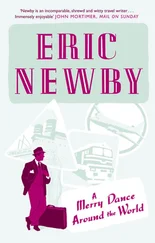What could I do but accept his generous offer? The idea of a holiday, with no strings attached, was very appealing — and I’d certainly think over what he’d said about working with him at Smith’s Pumps.
He seemed pleased enough at that, for he shook my hand warmly. Then he reached into an inside pocket of his jacket and handed me an envelope bulging with banknotes. “This’ll cover your expenses.”
I protested that I could pay my own way.
“Not at all,” he said. “This is a business matter. As soon as I get home, my travel agent will arrange an open first-class ticket in your name on any ship of your choice from Panama to Quebec City. A sea voyage’ll give you another few weeks to relax in the fresh air — and this time you won’t be a deckhand. From Quebec, you can catch a train to Camberloo. I’ll look forward to seeing you there in the not-too-distant future.”
We shook hands again and he rushed off to his jeep. No sooner had he gone than the hospital doctor, in the best of spirits, came to see me. Apparently Señor Smith had slipped him a few thousand pesos in return for taking especially good care of me till I was ready to leave.
He did take good care of me. Two weeks later, I was fit to travel.
During the three-week voyage from Panama to Quebec City on a recently built cargo ship, the SS Gardeyloo , I avoided my fellow passengers as much as possible. It was easily done, for there were only a dozen or so and they didn’t seem all that interested in socializing with a walking skeleton. I read and ate and drank in the privacy of my cabin, which was as big as the combined living quarters of the Charybdis ’s entire group of deckhands.
Some remnants of my bout of dengue fever persisted in the form of occasional dizziness and a fear of the mosquitoes that made half the voyage with us. But I’d started to put on a little weight again, despite how emaciated I might have looked to others. I was feeling alert by the time the ship was sailing up the Gulf of St. Lawrence. That sensation of slowly entering the gullet of a great beast, which must have affected centuries of immigrants, moved me too.
In the end, the Gardeyloo moored at the docks in Quebec City. Passengers and cargo alike were deposited at the harbourfront on a hot and windy July day. From there, I went to the railway station and caught the train for the ten-hour journey westwards.
THE LAST HUNDRED miles of the approach to Camberloo were through a landscape with no lakes and no mountain ranges, in fact scarcely a hill of note. The near-empty train rolled past enclosed fields, some with stone farmhouses that might have been imported from the pastoral Lowlands of Scotland, and neat little towns with glimpses of quiet streets and church steeples. There were occasional patches of forest, some of the trees quite ancient-looking — relics, perhaps, of the original great forests that had once covered the land.
At last, the train slowly crossed an iron bridge over a placidlooking stream — the Grand River, according to a flaking sign on the bridge — and came into the outskirts of Camberloo, which seemed to be a larger version of the other towns we’d passed. A mile or so of further reluctant slowing down and the train squealed to a halt at Camberloo station.
The time was three o’clock.
I WAS THE ONLY passenger to climb down onto the sunny, deserted platform. The overwhelming heat surprised me — I’d expected the summer weather here to be nothing to me, after being so long in the tropics. Perhaps I’d become too used to the air-conditioned climate of the train, so this dry, stifling heat made me feel a little dizzy. I’d trouble sucking in oxygen and my knitted sweater bought especially for Canada’s arctic chills prickled my flesh.
Behind me the train slowly began to move away from the station. In the background of all its roaring and hissing and thumping, a mad voice was howling. But there wasn’t another person around. When the train had passed, I realized the howling was actually the noise of another, higher-pitched machine. It came from just across the tracks where an old factory with hundreds of sooty windowpanes vomited yellow smoke into the blue sky.
As I stood in the awful heat, I couldn’t help wondering why I’d ever agreed to come to such an unprepossessing place. Yet here I was and it was too late for second thoughts.
Nor was there any point in just standing there broiling in the sun, for no one would be coming to meet me. Gordon Smith had telegraphed the Gardeyloo the day before it arrived at Quebec City to say a room was reserved for me at a place called the Walner Hotel. Whenever I arrived, I was to make my own way there and he’d be in touch with me. So I picked up my canvas holdall and went into the station waiting room.
Immediately I felt much better. This waiting room wasn’t air-conditioned, but after the heat and glare of the platform it was quite refreshing. There was no one around except for a ticket clerk who looked up from his wicket when I came in. He was a middle-aged man with lank, sparse hair, carefully draped over his skull in a way that drew attention to his near-baldness.
I asked him how to get to the Walner Hotel.
“It’s about a ten-minute walk,” he said, looking me over doubtfully. “It’s a fairly expensive place, you know.”
With my unsuitable wool sweater and canvas bag I must have seemed an unlikely guest for the hotel in question. I told him that a room had been reserved for me there.
His eyebrows rose.
“Ah,” he said. “Well, it’s just along King Street. I can call you a taxi if you like.”
I felt a walk might be good for me after sitting so long in the train. So I asked him for directions to the hotel, went outside again, and with my bag in hand — it had nothing in it but a change of clothes, some paperbacks, and the jungle-stained notebook that was to be my epitaph before Gordon Smith came on the scene — I began to walk.
To get to King Street, I followed a side street the clerk had told me to take. It was lined with trees and big houses built in what I took to be the Gothic style, many of them with fake turrets and cupolas. They were so alike they might all have been designed by the same architect. But the old oaks and maples, which in some places formed a leafy archway over the street, grew according to their own rather individual plans. These trees, like many of those I’d seen from the train, must have already been huge long before Camberloo came into existence.
Eventually I got to King Street, which was treeless. The architecture here was of a different type, too — though, again, there was a sameness about it. Red-brick buildings of a commercial sort dominated. Some were big and square, some were small and square, but otherwise they were mainly distinguished from one another by such overhead signs as Grimm’s Tailor, The Hardware Company , and The Pig’s Eye Pub .
The buildings all seemed to be of much the same age — as though on a given day eighty years ago, perhaps, King Street in its entirety had been plopped down here. If any of the buildings were more recent, it was hard to tell, they’d been made to fit in so unobtrusively.
No sooner was I on King Street than I began encountering flies. These Camberloo flies were big and unpredictable, so it was hard to avoid bumping into them. After these collisions, they’d just buzz a little louder and continue on their way. In that sense, they were unlike those persistent little jungle flies I’d learned to hate — flies that howled and never missed an opportunity to bite or sting.
On this first walk along King Street I didn’t see a great number of pedestrians. Most of those I did pass were ordinarylooking and forgettable and avoided eye contact.
Читать дальше











